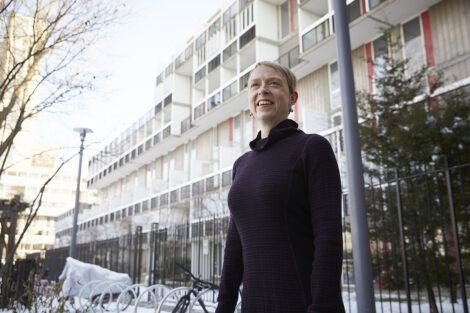Adele Houghton, DrPH ’23, is creating new tools to help real estate teams become more responsive to the health needs of their buildings’ occupants and the surrounding communities
February 18, 2022—Adele Houghton fell in love with architecture as an undergraduate at Princeton after a professor described the field as a new way to see the world. Much as a botanist brings a specialist’s eye to a walk in the forest, Houghton was soon seeing the buildings she passed on the street as the products of architects’ decisions, and noticing the way that they did—or didn’t—connect with their communities. And when she started working on her own building projects, she realized something very important was often left out of planning discussions: the health and wellbeing of the future occupants. That revelation started her on a new career path exploring the intersection between the built environment and public health.
“Unless it’s a project with specialized needs, such as a preschool or a retirement home, architects tend to take the people inhabiting their buildings for granted,” said Houghton, now in her second year in the Doctor of Public Health (DrPH) program at Harvard T.H. Chan School of Public Health. “We’re not taught about what makes a population similar or different than others, and how those differences might affect health.” The more she thought about this, the stranger it seemed to her. “I mean, buildings are built for people,” she said.
Houghton knows firsthand how the environment can influence health. She suffered from asthma as a child, and now suspects that it was exacerbated by poor ventilation and outdoor air pollution. When she became an architect, Houghton focused on environmentally sustainable materials and methods.
Several years into her career, she became a project manager at the nonprofit Green Guide for Health Care, where she helped develop the first quantifiable sustainable design, construction, and operations toolkit for the U.S. healthcare industry.
The work sparked her interest in understanding the environmental and social determinants of health more broadly. In 2011, she began an MPH at Johns Hopkins Bloomberg School of Public Health and started exploring ways to bring health into the building development process from the beginning. Ultimately, her research coalesced into the idea for a new field of practice she called architectural epidemiology.
“It’s important to tailor a design so that it’s going to have the best and the biggest impact on its environmental and social context,” Houghton said. She describes architectural epidemiology as a framework for “turning small scale real estate decisions into large-scale action on climate change and chronic disease.”
Houghton utilizes this framework at Biositu, the green building consulting company she launched in 2008, and has a book coming out this year that lays out her methods. She came to Harvard Chan School in 2020 with the goal of building a community around architectural epidemiology, and to learn what it will take to change the industry.
A co-benefits approach
During her first year in the DrPH program, she launched a venture at the Harvard Innovation Labs called ArchEPI, a web tool that taps into an array of available datasets to help local governments, community groups, and real estate developers align around health and climate priorities such as reducing air pollution. The aim is to inspire developers to commit to climate- and health-friendly actions that they might not otherwise have taken, and for cities to provide incentives for this behavior, Houghton said.
She has also been a student ambassador with C-CHANGE (The Center for Climate, Health, and the Global Environment), a program that provides training and support for students working on climate change and health.
These experiences have been key as she continues to develop her research, Houghton said. “There are structures around students at Harvard Chan School that allow us to incubate our thoughts so that they can be more crystallized and brought out into the world successfully.”
For her summer immersion project last year, Houghton worked with HKS, Inc., a 1,200-person global architecture firm based in Dallas, Texas, on a new framework for developing building projects using what she calls a co-benefits approach. Rather than holding separate conversations on factors such as energy efficiency, air quality, and return on investment, this approach encourages builders and clients to examine projects holistically.
In the process, it can expose blind spots “like the fragility of urban office buildings that prioritized energy efficiency at the expense of all other risks, including an airborne virus and an increasing number of power outages caused by climate-fueled extreme weather events,” Houghton wrote in a September 2021 post on Harvard Chan’s DrPH program website. A representative from HKS shared the co-benefits approach at the United Nations Climate Change Conference (COP26) in Glasgow, Scotland, last fall.
Now, Houghton is working on defining her doctoral project while also preparing to launch her book. After graduation, she sees herself likely teaching architectural epidemiology methods to students in public health, architecture, and allied fields while also growing her efforts to move the building sector from a contributor to chronic disease and environmental harm to a driver of positive change.
“Adele is in this for the long-haul,” said Fawn Phelps, director of leadership development in the Office of Educational Programs and a DrPH program adviser. “She is dedicated to the slow work of shifting the practice of architecture and construction to better align with the stark reality of climate change all in the face of well-funded interests that are thriving within the current outdated real estate development culture. She sees the obstacles with clear eyes and is deeply dedicated to pushing forward to a better built world.”
“I want to demonstrate that this approach is possible and that everyone can win,” Houghton said.
Photo: Kent Dayton
